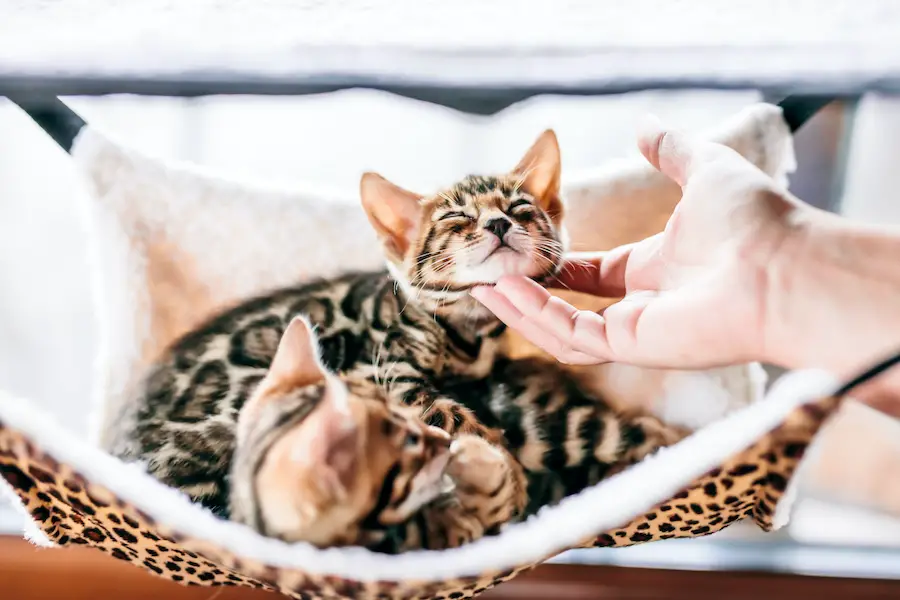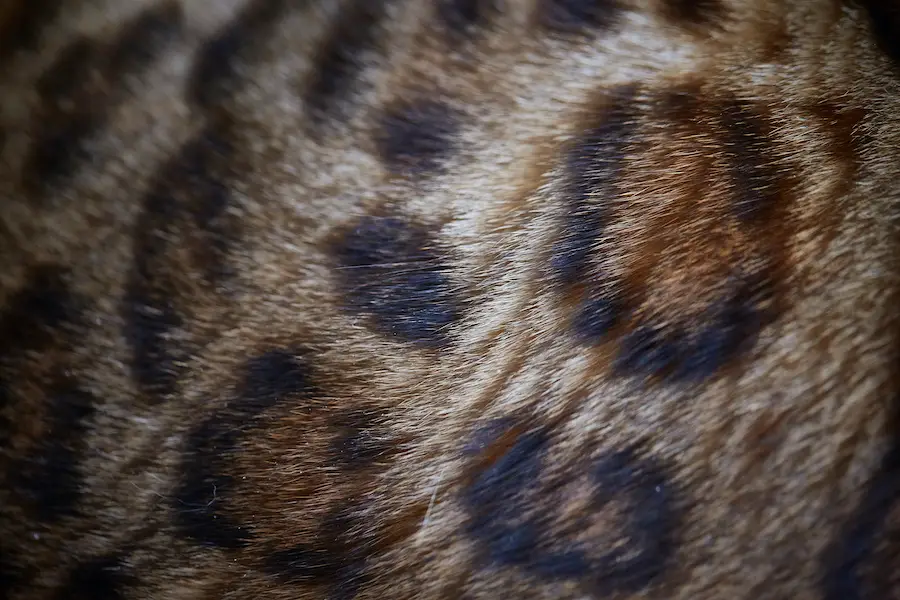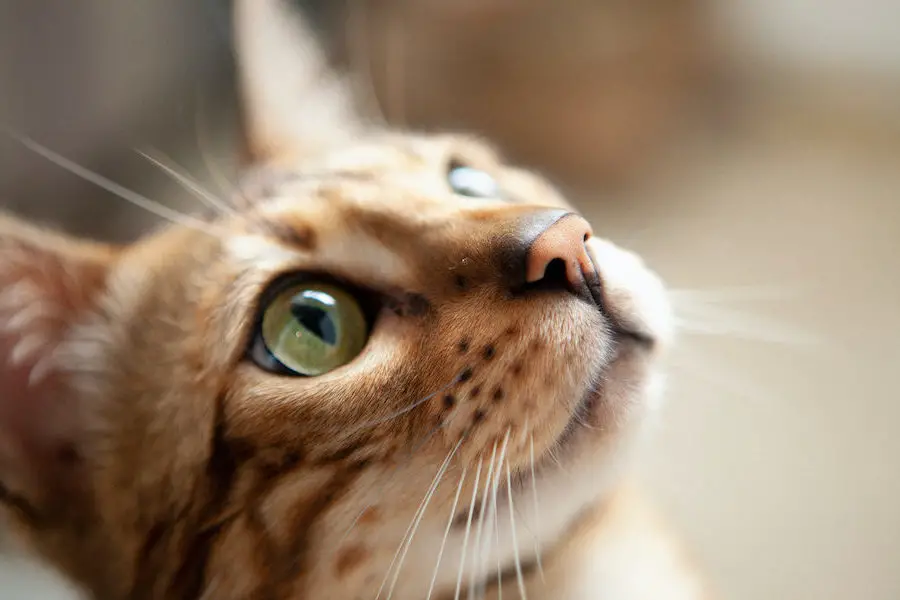Bengals in the United States are bred for specific characteristics: rosette or marbleized (spotted), golden or seal lynx points, and sepia brown. There is also mink coloring which is what you’d get if you diluted these three colors to grey shades.
Bengals come in three pattern choices: spotted, marbled, and solid. The signature pattern of the Bengal breed is the rosette. Rosettes are not always easy to recognize, especially when they are kitten prints or blend into tabby markings that disappear into a solid.
Bengal Cat Average Lifespan: 15 years
Bengal Cat Average Size: 10-18 lbs.
What Are Bengal Cats’ Personalities Like?
Bengal cat personalities vary greatly. The most common personality is that of a very active and intelligent cat. They like to be mischievous, getting into all sorts of things – and sometimes they can be destructive if not watched carefully. Their intelligence means they are easily trainable, even at an early age. Bengals are known for being especially social with both people and other pets. However, this intelligence can also mean they are very demanding of your attention. If they want something, be it food or playtime or to go outside, they will tell you! That’s why providing feline enrichment is paramount to a happy and healthy Bengal cat. If you’re thinking of getting a Bengal, it’s important to understand the general temperament and needs of this breed before bringing one home. They can be quite active and will often make noise in the middle of the night if they become bored or stressed. Bengals also do not tolerate changes well and may lash out in response to these kinds of stressors. While this breed is generally gentle, some can be more temperamental.

How Big Do Bengal Cats Get?
Bengals typically weigh between 10 and 18 pounds and stand almost as tall as they are long. A healthy, well-fed Bengal can reach full size within three to four years if kept indoors. If allowed to roam outdoors, they may not reach their full size at all.
What Is The Origin Of The Bengal Cat?
Bengal cats are believed to have originated in the 1920s when a domestic cat gave birth to a spotted black kitten in the home of Jean S. Mill of Massachusetts. These litters were considered unusual because all of the kittens had the same markings, similar to those of the leopard. Mill’s, an amateur breeder, soon began breeding these kittens with other spotted breeds. This led her to become one of the first people in the United States to breed Bengals. Most Bengals bred in the US are bred for specific characteristics. These include rosette or marbleized coat patterns. The typical lifespan of a Bengal cat is 15 years.

Rosette pattern of a Bengal cat’s coat
Common Health Issues Affecting Bengal Cats
The most common medical issues affecting Bengal cats are related to their genetics. These include problems with the exocrine pancreas, which is responsible for producing enzymes crucial in helping to break down and absorb food in the intestine; cardiomyopathy (a disease of the heart muscle); erythrocyte Pyruvate Kinase Deficiency (PK Deficiency), an enzyme required for normal blood clotting; and various forms of muscular dystrophy.
Genetic problems affecting Bengals specifically can lead to issues like epilepsy, which results in seizures; hypertrophic cardiomyopathy (HCM), where the heart muscle becomes too thick, leading to congestive heart failure; or renal amyloidosis (RA), which over time destroys the kidneys. RA is caused by depositions of abnormal proteins called amyloids, which eventually take over normal kidney tissue. Amyloids can be deposited anywhere in the body, but those affecting the kidneys are called “renal amyloids” and they eventually destroy the organ.
The Bengal breed is also known to be predisposed to systemic lupus erythematosus (SLE), a disease of the immune system where antibodies mistakenly target and damage healthy tissue; and melanoma, cancer that begins in pigment-containing cells called melanocytes and can spread to other organs.
Other common health complaints among Bengals include problems like inflammatory bowel disease (IBD); hyperaesthesia (abnormal sensitivity to stimuli, causing discomfort), often evidenced by the cat hissing and arching its back when touched; tearing of the eyes because cats are unable to properly close their eyelids; and pica (eating things that are not food, like plastic bags) which could result from mineral deficiencies.
Other problems that affect Bengals include dermatitis (inflamed skin) due to allergies; urinary tract infections; ear infections; heart defects such as subaortic stenosis (SAS), where the heart muscle between the ventricles becomes too thick, leading to congestive heart failure; and persistent pupillary membranes (tiny strands of tissue that connect to the colored part of the eye).
Some Bengals are also born with a genetic defect called “feline cerebellar degeneration” or FCGD. Those cats develop neurological signs similar to those seen in feline infectious peritonitis (FIP) including ataxia (incoordination), tremors, difficulty eating or swallowing, circling, falling down or rolling over, blindness, seizures and even coma. The disease is usually fatal within weeks after symptoms begin. If you choose to buy a Bengal cat, be sure you’re dealing with a reputable and ethical breeder. Many will offer health guarantees.
Conclusion
Bengal cats make good pets because they are intelligent, affectionate, and generally very healthy. They are known to be easy to train because of their intelligence, which is also why these cats can easily become bored or frustrated if not stimulated properly. Bengals are loving toward their human family members and tend to form tight bonds with them. They seek out physical contact with other family members as well as demand attention from them regularly. Bengals that do not receive the proper amount of attention can develop behavior problems so be sure that you’re willing to dedicate the time and attention that your Bengal kitty needs and deserves.
